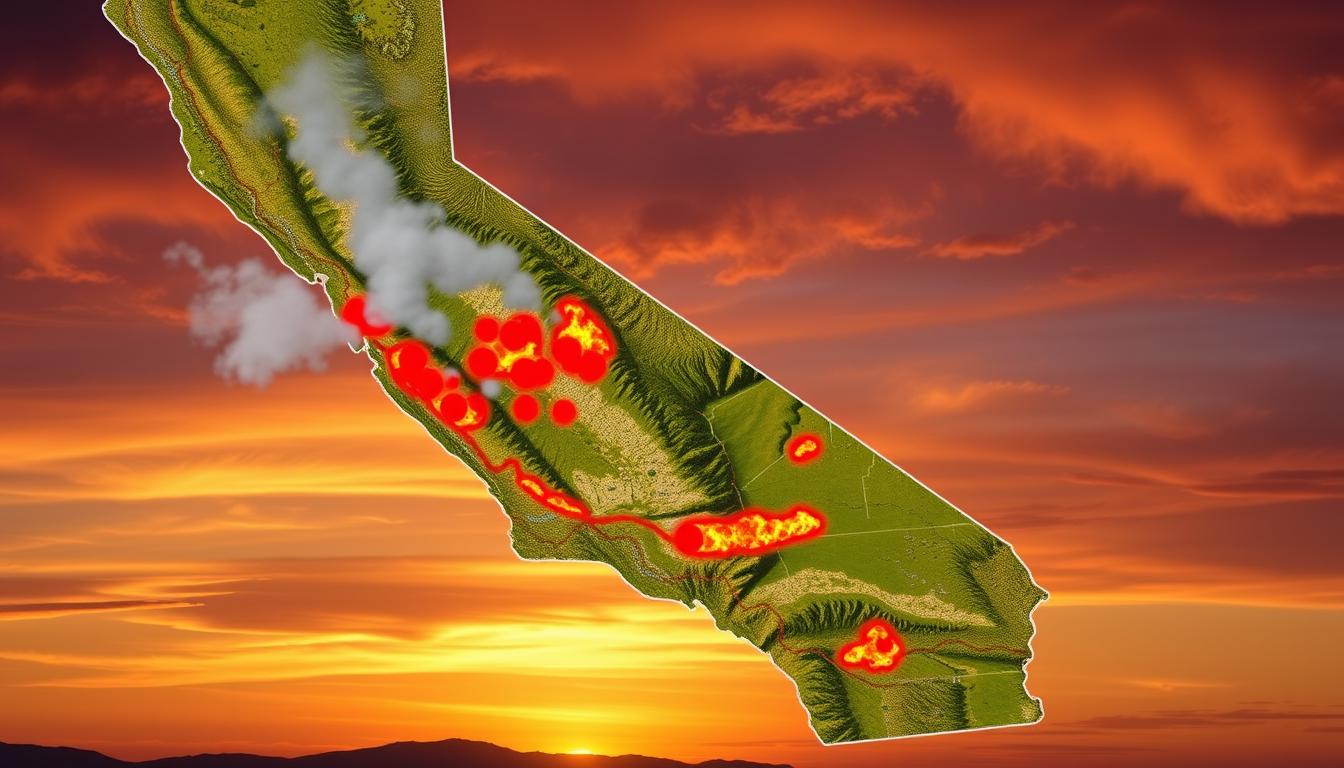Staying informed is key during wildfire season in California. Over 7,000 wildfires happen every year, burning hundreds of thousands of acres. A reliable california fires map is crucial. It gives current fire info, helping you track fires and get live updates.
The Frontline Wildfire Defense App is a great tool. It lets users track fires and get alerts on active fires and evacuation routes. This helps residents prepare and respond to fires.
Key Takeaways
- The frequency of wildfires in California highlights the need for real-time information.
- Accessing a live fire map can save lives by providing critical updates and evacuation routes.
- Emergency fire maps help coordinate community response during fire incidents.
- Utilizing mobile apps enhances your ability to stay informed on the go.
- Engaging with local firefighting efforts strengthens community resilience.
- Understanding current fire conditions can assist in personal safety preparations.
Understanding the Importance of California Fires Maps
California fires maps are key tools that give us real-time updates on wildfires. They show where fires are, how much they’ve spread, and if they’re being controlled. This info is vital for firefighters and people living near fires, helping keep everyone safe.
What Information Do They Provide?
A detailed wildfire map shares important data, such as:
- Active fire locations and their sizes
- Fire incident updates, including containment percentages
- Fire spread tracking to help predict future behavior
- Evacuation routes and zones to facilitate safe departures
This info helps people decide when to leave and how to stay safe. With over 100,000 people under evacuation orders in California, it’s crucial.
How Do They Help Communities?
These maps are essential for keeping communities safe during wildfires. They help with:
- Quick access to the latest fire incident updates for those in threatened areas
- Informed decision-making regarding personal safety and property protection
- Resource allocation and mobilization by local authorities and emergency services
Fires can spread fast, sometimes covering 20,000 acres in a day. Communities must act quickly. With accurate wildfire maps, people can better prepare and stay safe.
How to Access Real-Time California Fires Maps
Residents can stay updated on California wildfires through various ways. Online resources offer timely fire updates, crucial for safety. These platforms provide maps and important info on incidents, air quality, and evacuation zones.
Online Resources for Live Updates
Many online resources are reliable wildfire trackers. Sites like CAL FIRE and the Statewide Fire Information website give fresh data on fires. The National Wildfire Coordinating Group’s Inciweb site offers federally managed fire data, giving users a wide range of accurate info.
Mobile Apps for Instant Notifications
Mobile apps make it easier to get fire updates. The Frontline Wildfire Defense App lets users set alerts based on their home addresses. Breezometer gives real-time air quality info, including smoke maps that can affect health, especially in kids. These apps offer quick access to fire updates right on your phone.
California Fires Map: Key Features to Look For
When using a California fires map, it’s important to know the key features. This helps stay informed and safe during wildfires. Look for fire perimeters and evacuation zones, which show where fires are and where to go.
A live wildfire map gives updates on fire locations. This lets people know what’s happening around them.
Fire Perimeters and Active Fires
Fire perimeters mark where fires are burning. They help understand how big and where fires are spreading. In Los Angeles County, nearly 180,000 people had to leave their homes due to fires.
Knowing these perimeters can save lives during emergencies.
Evacuation Zones and Road Closures
Evacuation zones help keep people safe from fires. They show where to go quickly. Cal Fire maps use red for mandatory evacuations and yellow for warnings.
Also, knowing about road closures is key for safe travel. Recently, over 179,000 people had to leave their homes. Staying informed about evacuation zones is crucial.
Overview of Major Fires in California History
California’s history has been marked by major fires. These fires pose immediate challenges and offer lessons for better preparation and response. The wildfire impact on the environment and people is huge. Fires like the Camp Fire in 2018 and Thomas Fire in 2017 show the destruction and loss they bring.
Notable Fires and Their Impact
Many fires have left their mark on California’s major fires history. The Camp Fire in 2018 burned 153,336 acres, destroyed 18,804 structures, and killed 86 people. The Thomas Fire in 2017 burned 281,893 acres and caused 23 deaths. These fires show the dangers faced by residents, especially in high-risk areas where over 2.7 million people live.
In 2020, over 4.5 million acres burned in California. This highlights the need for better California fire coverage and prevention. From 2000 to 2023, an average of about 975,000 acres burned each year.
Lessons Learned from Past Incidents
Every devastating fire teaches us about fire management and community readiness. Most wildfires in California are caused by humans, showing the need for public awareness and responsible land use. Studies show that 58% of wildfire-affected areas were hit in 2020 and 2021, making it crucial to update fire prevention and education strategies.
Preparedness is essential since fires can happen any time of the year. They remind us of the need for resilience and adaptation in the face of these threats.
The Role of Government Agencies in Fire Mapping
Government agencies are key in keeping fire maps up to date. Cal Fire and the National Weather Service work together. They gather important data and share it with the public. This helps manage fires in real time and prepares communities for wildfires.
Cal Fire’s Involvement
Cal Fire leads in fire management in California. They collect data on active fires, fire perimeters, and past incidents. They use the latest technology to share this info, helping emergency services and people in fire-prone areas.
Their work includes:
- Using fire mapping resources for interactive maps for residents.
- Being part of incident command and management for better responses.
- Running community programs to teach people about fire risks.
National Weather Service Contributions
The National Weather Service is also crucial. They provide weather data that affects fires. This includes forecasts on weather, wind, and humidity. This data helps plan for wildfires.
Some of their contributions are:
- Issuing alerts for extreme weather that raises fire danger.
- Reporting on air quality near communities.
- Working with Cal Fire to share integrated data.
In summary, Cal Fire and the National Weather Service work together. They keep fire maps updated and available. This helps emergency services fight fires better and keeps communities informed and ready for wildfires.
How Technology Enhances Fire Mapping
Technology has greatly improved fire mapping, especially in California where wildfires are common. Tools like satellite data and fire detection technology help responders and researchers. They use these tools to understand fire behavior and make better decisions.
Combining satellite imagery, drones, and Geographic Information Systems (GIS) makes fire mapping more efficient and accurate. This helps in managing wildfires better.
Satellite Imagery and Drones
Satellite data and drones have changed how we detect fires in California. They give real-time updates on fires, helping agencies track their spread. Drones, for example, have become more important in fighting wildfires.
They help with aerial ignition and quick assessments. The ALERTCalifornia program uses high-definition cameras for 360-degree sweeps every two minutes. This gives first responders vital information during emergencies.
Geographic Information Systems (GIS)
GIS adds a new level to fire mapping by analyzing data. It creates detailed maps showing fire risks and locations. AI tools make this process even better, improving fire detection.
The Fire Integrated Real-Time Intelligence System (FIRIS) is a great example of GIS in action. It provides real-time maps to first responders. In 2023, California treated 700,000 acres to prevent wildfires. GIS helps make emergency responses more effective, saving communities.
Understanding Fire Risk Levels
Fire risk levels are shown through a color-coded system. This makes it easy for people to see how dangerous their area is. Knowing what these colors mean is key to staying safe and ready for emergencies.
What Do the Colors Mean?
The National Fire Danger Rating System (NFDRS) uses five colors to show fire danger:
- Green: Low fire danger potential
- Blue: Moderate fire danger potential
- Yellow: High fire danger
- Orange: Very high fire danger
- Red: Extreme fire danger
These colors help us see fire danger in different places. For example, red means extreme danger. Fires are hard to control, and quick action is needed.
How to Interpret Risk Assessments
Understanding risk assessments is vital for fire safety. The Wildfire Risk Index (WRI) helps by showing risk levels. Most of California faces high risks, according to the WRI.
Using Geographic Information Systems (GIS) data helps too. Local agencies can show where fire dangers are highest. This helps everyone know how to stay safe.
| Risk Level | Description | Recommended Actions |
|---|---|---|
| Very Low (VL) | Minimal risk of fire occurrence | Routine monitoring of conditions |
| Low (L) | Low likelihood of fire, slight precautions advised | Maintain clear defensible space |
| Medium (M) | Moderate risk, conditions favorable for fire | Increase awareness; prepare emergency kits |
| High (H) | High chance of fire, immediate vigilance needed | Implement fire prevention measures |
| Very High (VH) | Severe risk with potential for rapid fire spread | Evacuation planning recommended; stay informed |
By checking fire risk levels often, communities can get safer. Knowing about fire risks helps everyone be ready. This makes a big difference in staying safe from fires.
Community Resources for Fire Preparedness
Being ready for fires means using community resources. This helps people get the tools and info they need to stay safe. Local fire departments are key, teaching about fire safety and offering training.
Local Fire Departments and Resources
Local fire departments are vital for fire safety. They teach classes on fire safety and prevention. They also hold drills and training to help people know what to do in a fire.
Emergency Services Contacts
It’s important to have emergency contacts ready. Here are some key ones:
| Service | Contact Number |
|---|---|
| FEMA Assistance | 1-800-621-3362 |
| American Red Cross | 1-800-RED-CROSS (1-800-733-2767) |
| California 211 | 211 |
| Disaster Legal Services Hotline | 888-382-3406 |
| California Poison Control | 1-800-222-1222 |
These contacts help get quick help in emergencies. With many facing wildfire risks, knowing where to get help is crucial. Using local resources keeps everyone informed and ready for fires, making our community safer.
Steps to Take in Case of Evacuation
Being ready can really help keep you safe when wildfires force you to leave. A good evacuation plan shows you where to go and where to stay. It also helps everyone in your family talk clearly when emergencies happen.
It’s important to have a list of things to pack before you have to leave. This way, you can leave quickly and easily.
Preparing an Evacuation Plan
A good evacuation plan has a few key steps:
- Find safe routes and places to stay before the fire starts.
- Choose spots where your family can meet up if you get separated.
- Learn the steps to evacuate that local authorities suggest.
- Check your plan often to make sure it still works.
What to Pack for Evacuation
Having a good list of things to pack can make leaving easier. Here are some important items to include:
| Item | Purpose |
|---|---|
| Medications | To keep you healthy while you’re away. |
| Important Documents | In case you need proof of who you are or own. |
| Clothes and Personal Items | To stay comfortable for a long time away from home. |
| Food and Water | To eat and drink if you can’t find food or water. |
| Pet Supplies | For taking care of your pets while you’re away. |
Engaging with Local Firefighting Efforts
Getting involved in local firefighting is key to building a stronger community. People can help in many ways, like joining volunteer firefighting groups or giving donations to firefighters. These efforts not only help fire departments but also bring the community closer together.
Volunteer Opportunities
Local fire departments often look for community members to join their teams. Volunteers get training and help during emergencies, keeping homes and lives safe. They can do things like:
- Going to training sessions to learn firefighting skills
- Helping out in drills and getting ready for emergencies
- Working on community outreach programs
- Helping with the upkeep of firefighting gear
Donations for Firefighting Resources
Donations are a big help to local fire departments. They can go toward things like protective gear, firefighting tools, and programs to reach out to the community. Here are some ways to give back:
- Donating money to local fire departments
- Giving supplies like food and water during big fires
- Helping out at fundraising events
The Future of Fire Mapping Technology
Fire mapping technology is on the brink of big changes. As wildfires grow more dangerous, tracking them better is key. California has invested $4 billion in fighting wildfires, combining new tech with old methods.
This move aims to fight more fires more effectively. The need for these tech advancements is clear as we face environmental challenges.
Innovations on the Horizon
New tools are promising for fire mapping. AI tools help spot fires faster and track them in real-time. LiDAR technology gives detailed 3D maps of risky areas, helping predict and respond to fires quicker.
- Drone use has doubled for tasks like starting fires and controlling them, making work more efficient.
- California plans to grow its aerial firefighting team with more helicopters and tankers, key for quick action.
- Over 700,000 acres have been treated to prevent wildfires, showing a proactive stance on fire management.
Predictions for Climate Change Impact
Climate change will make fighting fires harder. Warmer temperatures and longer droughts will make fires worse. So, we need to keep improving our fire mapping tech.
Expanding how we report on fires online aims to keep the public informed. This shows the need for clear info during wildfires.
| Investment Area | Budget ($ billion) | Duration |
|---|---|---|
| Total Investment in Wildfire Resilience | 4 | Current Year |
| Annual Investment in Forest and Fire Prevention | 0.2 | 2028-29 |
| Investment in Drones and AI Integration | Confidential | Ongoing |
Using these new technologies is crucial for fighting wildfires. It marks a big change towards better fire management. As California battles unpredictable fires, better mapping tools are more important than ever.
Staying Informed: Tips for Monitoring Fires
In today’s world, knowing about wildfires is key. Use social media, community forums, and trusted news to stay updated. Local groups on Facebook offer real-time info and important discussions.
Social Media and Community Forums
Social media is a great way to keep up with fires. Join forums and follow fire departments to get alerts. Apps like Genasys Protect send emergency updates, helping you track fires.
News Outlets to Follow for Updates
But, always check credible news for wildfire info. The National Weather Service gives forecasts and warnings. Updates on evacuations and road closures are also vital, especially in places like Los Angeles County.




